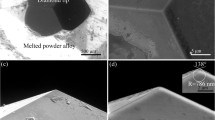Abstract
The formation of scratches on silicon dioxide surfaces during chemical mechanical planarization in the semiconductor manufacturing process is a significant concern, as it adversely affects yield and reliability. In this study, scratch formation during CMP processing of the oxide surface was examined. The shapes of the resulting scratches were classified into three types: chatter mark type, line type, and rolling type. Chatter mark types were further subdivided into line chatter, broken chatter, and group chatter based on the shape. The effect of three different scratch sources (viz., pad debris, dried particles, and diamond particles) on scratch formation was comprehensively investigated. Chatter-mark-type scratches are predominant in the presence of agglomerated particles and pad debris. Group chatter marks are caused by the addition of pad debris. Unique scratch formation was observed on the wafer with different scratch sources. In particular, multiple-line-type scratches were observed in the presence of diamond particles.









Similar content being viewed by others
References
Choi, J.G., Prasad, Y.N., Kim, I.K., Kim, I.G., Kim, W.J., Busnaina, A.A., Park, J.G.: Analysis of scratches formed on oxide surface during chemical mechanical planarization. J. Electrochem. Soc. 157, H186–H191 (2010)
Li, Y.: Microelectronic applications of chemical mechanical planarization. Wiley Interscience, New York (2007)
Ring, T.A., Feeney, P., Boldridge, D., Kasthurirangan, J., Li, S., Dirksen, J.A.: Brittle and ductile fracture mechanics analysis of surface damage caused during CMP. J. Electrochem. Soc. 154, H239–H249 (2007)
Seo, Y.J., Kim, S.Y., Lee, W.S.: Reduction of process defects using a modified set-up for chemical mechanical polishing equipment. Microelectron. Eng. 65, 371–379 (2003)
Lee, S.I., Hwang, J., Kim, H., Jeong, H.: Investigation of polishing characteristics of shallow trench isolation chemical mechanical planarization with different types of slurries. Microelectron. Eng. 84, 626–630 (2007)
Choi, J.G., Prasad, Y.N., Kim, I.K., Kim, W.J., Park, J.G.: The synergetic role of pores and grooves of the pad on the scratch formation during STI CMP. J. Electrochem. Soc. 157, H806–H809 (2010)
Zhang, S.L., Li, J.C.M.: Slip process of stick–slip motion in the scratching of a polymer. Mater. Sci. Eng., A 344, 182–189 (2003)
Armini, S., Whelan, C.M., Maex, K., Hernandez, J.L., Moinpour, M.: Composite polymer-core silica-shell abrasive particles during oxide CMP: a defectivity study. J. Electrochem. Soc. 154, H667–H671 (2007)
Ahn, Y., Yoon, J.Y., Baek, C.W., Kim, Y.K.: Chemical mechanical polishing by colloidal silica-based slurry for micro-scratch reduction. Wear 257, 785–789 (2004)
Prasad, Y.N., Kwon, T.Y., Kim, I.K., Kim, I.G., Park, J.G.: Generation of pad debris during oxide CMP process and its role in scratch formation. J. Electrochem. Soc. 158, H394–H400 (2011)
Gao, C., Kuhlmann-Wilsdorf, D., Makel, D.D.: Fundamentals of stick–slip. Wear 162–164, 1139–1149 (1993)
Gao, C., Wilsdorf, D.K., Makel, D.D.: The dynamic analysis of stick–slip motion. Wear 173, 1–12 (1994)
Suratwala, T., Wong, L., Miller, P., Feit, M.D., Menapace, J., Steele, R., Davis, P., Walmer, D.: Sub-surface mechanical damage distributions during grinding of fused silica. J. Non-Cryst. Solids 352, 5601–5617 (2006)
Suratwala, T., Steele, R., Feit, M.D., Wong, L., Miller, P., Menapace, J., Davis, P.: Effect of rogue particles on the sub-surface damage of fused silica during grinding/polishing. J. Non-Cryst. Solids 354, 2023–2037 (2008)
Abbadie, A., Cresente, F., Séméria, M.N.: Advanced wet cleaning post-CMP. Application to reclaim wafers. J. Electrochem. Soc. 151, G57–G66 (2004)
Kim, S.Y., Park, S.W., Seo, Y.J.: Improvements of CMP characteristics using slurry filter and high-spray bar of de-ionized water. J. Mater. Sci: Mater. Electron. 13, 693–696 (2002)
Kasai, T., Dowell, C., Somanchi, A.: Applications of a laser assisted defect detection system for chemical mechanical planarization (CMP) slurry development in rigid disk polishing. Meas. Sci. Technol. 18, 1582–1590 (2007)
Teo, T.Y., Goh, W.L., Leong, L.S., Lim, V.S.K., Tse, T.Y., Chan, L.: Characterization and reduction of copper chemical mechanical polishing induced scratches. Proc. SPIE 5041, 61–69 (2003). doi:10.1117/12.485223
Acknowledgments
This work was supported by the Basic Science Research Program through the National Research Foundation of Korea (NRF) funded by the Ministry of Education, Science and Technology (2008-0061862) and an international cooperation program managed by the National Research Foundation of Korea (2012-0006294). We are grateful to Dow Electronic Materials, Cheil Industries, and Shinhan Diamond Corporation for providing pads, slurry, and diamond conditioners, respectively.
Author information
Authors and Affiliations
Corresponding author
Rights and permissions
About this article
Cite this article
Kwon, TY., Cho, BJ., Ramachandran, M. et al. Investigation of Source-Based Scratch Formation During Oxide Chemical Mechanical Planarization. Tribol Lett 50, 169–175 (2013). https://doi.org/10.1007/s11249-012-0098-2
Received:
Accepted:
Published:
Issue Date:
DOI: https://doi.org/10.1007/s11249-012-0098-2




